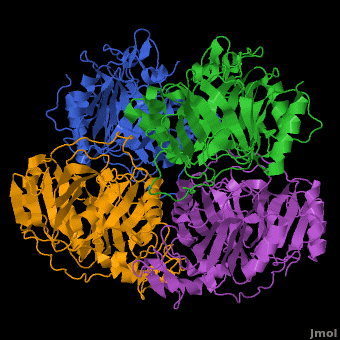Dioxygenase
From Proteopedia
(Difference between revisions)
| Line 8: | Line 8: | ||
* '''Glyoxalase/bleomycin resistant protein/dioxygenase''' (GBD) catalyzes the cleavage of S-lactoyl-glutathione to methylglyoxal and glutathione. | * '''Glyoxalase/bleomycin resistant protein/dioxygenase''' (GBD) catalyzes the cleavage of S-lactoyl-glutathione to methylglyoxal and glutathione. | ||
| - | === A Hyperactive Cobalt-Substituted Extradiol-Cleaving Catechol Dioxygenase | + | === A Hyperactive Cobalt-Substituted Extradiol-Cleaving Catechol Dioxygenase <ref>DOI 10.1007/s00775-010-0732-0</ref>=== |
| - | + | ||
| - | + | ||
| - | + | ||
In most metalloenzyme mechanisms, O<sub>2</sub> is reductively activated by direct electron transfer from the reduced metal ion. This implies that the rate of the reaction should be strongly dependent on the redox potential of the catalytic metal. We have proposed a different strategy for the Fe(II)-containing extradiol aromatic ring-cleaving dioxygenase family in which the activating electron is derived from the aromatic substrate rather the iron. When the aromatic substrate and the O<sub>2</sub> are bound to the metal at the same time, the metal may serve as a conduit for the activating electron. Since there is no net change in metal oxidation state during this process, the impact of the redox potential of the metal on oxygen activation should be minimal, so long as it is low enough to allow formation of the initial O<sub>2</sub> complex. This hypothesis is tested here by substituting Co(II) for Fe(II) in the <scene name='Journal:JBIC:5/Cobalt_overview/1'>Homoprotocatechuate 2,3-dioxygenase</scene> (2,3-HPCD) from ''Brevibacterium fuscum''. | In most metalloenzyme mechanisms, O<sub>2</sub> is reductively activated by direct electron transfer from the reduced metal ion. This implies that the rate of the reaction should be strongly dependent on the redox potential of the catalytic metal. We have proposed a different strategy for the Fe(II)-containing extradiol aromatic ring-cleaving dioxygenase family in which the activating electron is derived from the aromatic substrate rather the iron. When the aromatic substrate and the O<sub>2</sub> are bound to the metal at the same time, the metal may serve as a conduit for the activating electron. Since there is no net change in metal oxidation state during this process, the impact of the redox potential of the metal on oxygen activation should be minimal, so long as it is low enough to allow formation of the initial O<sub>2</sub> complex. This hypothesis is tested here by substituting Co(II) for Fe(II) in the <scene name='Journal:JBIC:5/Cobalt_overview/1'>Homoprotocatechuate 2,3-dioxygenase</scene> (2,3-HPCD) from ''Brevibacterium fuscum''. | ||
| Line 339: | Line 337: | ||
}} | }} | ||
| + | <references/> | ||
[[Category:Topic Page]] | [[Category:Topic Page]] | ||
Revision as of 10:56, 7 May 2015
| |||||||||||
3D structures of Protocatechuate 3,4-dioxygenase
Updated on 07-May-2015
- ↑ Fielding AJ, Kovaleva EG, Farquhar ER, Lipscomb JD, Que L Jr. A hyperactive cobalt-substituted extradiol-cleaving catechol dioxygenase. J Biol Inorg Chem. 2010 Dec 14. PMID:21153851 doi:10.1007/s00775-010-0732-0
Proteopedia Page Contributors and Editors (what is this?)
Michal Harel, Alexander Berchansky, Joel L. Sussman, Jaime Prilusky

